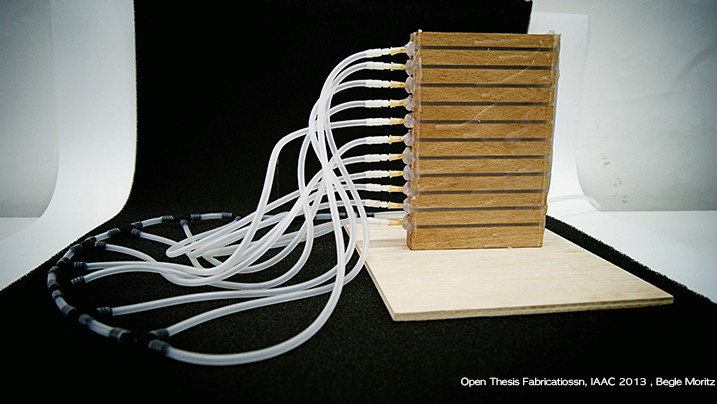 Today, we are facing a change in paradigm in the field of Architecture. Information Era Technologies and their impacts on architecture are drastically changing, and their relationship calls for new or adapted concepts, where physical space seamlessly intertwines with digital content, and where the language of electronic connections tie in with that of physical connections. We are consequently moving towards a different form of “habitats”, where architecture is not merely inhabited, but becomes technologically integrated, interactive and evolutional. If computers were once the size of buildings, buildings are now becoming computers, both performative, on I/O Communication protocols, and programmable, at material-molecule nanoscale, or even operational thanks to self-learning genetic algorithms. The methodology of Intelligent Constructions is based on two main paths. On one hand, Intelligent constructions tackles questions regarding Material Intelligence. Smart materials such as shape-memory materials, piezoelectric, thermoelectric or bio-materials able to adjust their properties to different environmental conditions, allow to programme buildings at a nanoscale, and open up a series of applications on an architectural scale and industrial applications. Furthermore, new composite materials that present preset combinations of mechanical properties or multi-functional properties of non-homogeneous materials in shape and composition across a wide range of scales bring forth the exploration of a shift in design culture, taking us to a new level of material awareness. Material Intelligence in combination with Artificial and Computational Intelligence, simulations, sensors, actuators, as well as with bio-mimetic innovations provide revolutionary ideas on growth, adaptability, repair, sensitivity, replication and energy savings in architecture. Should we continue constructing rigid and fixed structures? Or can buildings begin to think?
Today, we are facing a change in paradigm in the field of Architecture. Information Era Technologies and their impacts on architecture are drastically changing, and their relationship calls for new or adapted concepts, where physical space seamlessly intertwines with digital content, and where the language of electronic connections tie in with that of physical connections. We are consequently moving towards a different form of “habitats”, where architecture is not merely inhabited, but becomes technologically integrated, interactive and evolutional. If computers were once the size of buildings, buildings are now becoming computers, both performative, on I/O Communication protocols, and programmable, at material-molecule nanoscale, or even operational thanks to self-learning genetic algorithms. The methodology of Intelligent Constructions is based on two main paths. On one hand, Intelligent constructions tackles questions regarding Material Intelligence. Smart materials such as shape-memory materials, piezoelectric, thermoelectric or bio-materials able to adjust their properties to different environmental conditions, allow to programme buildings at a nanoscale, and open up a series of applications on an architectural scale and industrial applications. Furthermore, new composite materials that present preset combinations of mechanical properties or multi-functional properties of non-homogeneous materials in shape and composition across a wide range of scales bring forth the exploration of a shift in design culture, taking us to a new level of material awareness. Material Intelligence in combination with Artificial and Computational Intelligence, simulations, sensors, actuators, as well as with bio-mimetic innovations provide revolutionary ideas on growth, adaptability, repair, sensitivity, replication and energy savings in architecture. Should we continue constructing rigid and fixed structures? Or can buildings begin to think?  This brings us to the second path investigated through Intelligent Constructions, that of Digital Fabrication. In design, architecture and many other disciplines, Computer Numerically Controlled (CNC) fabrication equipment has given designers unprecedented means for executing formally challenging projects directly from the computer. Digital fabrication gives us the potential and the ability to design and fabricate building components with varied properties of density, translucency, elasticity and much more. Though, until now, Digital Fabrication tools are used by the designers to materialize their design by accessing materials as a library of consistent and physically homogeneous properties. The Intelligent Constructions research line wishes to explore how Digital Fabrication goes beyond assigning material properties into rigid construction components. The group works with digital content, information and fabrication for the generation of new techniques generating the production of non-rigid, responsive and multi-functional material and construction systems. Hence generating an architecture that is not just mimicking the living but is roaring into life. The method of investigation follows a rigorously experimental approach and progresses in complexity from small scale material sampling to the production of 1:1 scale architectural components and prototypes.
This brings us to the second path investigated through Intelligent Constructions, that of Digital Fabrication. In design, architecture and many other disciplines, Computer Numerically Controlled (CNC) fabrication equipment has given designers unprecedented means for executing formally challenging projects directly from the computer. Digital fabrication gives us the potential and the ability to design and fabricate building components with varied properties of density, translucency, elasticity and much more. Though, until now, Digital Fabrication tools are used by the designers to materialize their design by accessing materials as a library of consistent and physically homogeneous properties. The Intelligent Constructions research line wishes to explore how Digital Fabrication goes beyond assigning material properties into rigid construction components. The group works with digital content, information and fabrication for the generation of new techniques generating the production of non-rigid, responsive and multi-functional material and construction systems. Hence generating an architecture that is not just mimicking the living but is roaring into life. The method of investigation follows a rigorously experimental approach and progresses in complexity from small scale material sampling to the production of 1:1 scale architectural components and prototypes.  Partner Institution: CITA- Center for Information, Technology and Architecture in Copenhagen
Partner Institution: CITA- Center for Information, Technology and Architecture in Copenhagen